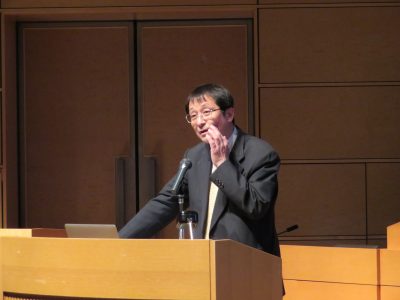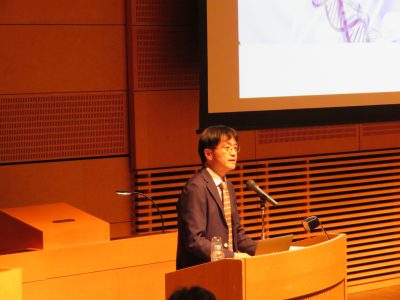2017 Tsukuba Global Science Week - Tsukuba Transborder Medical Research Center presentations
MEDIA RELEASE
TRANSBORDER MEDICAL RESEARCH CENTER HOLDS
INTERNATIONAL SYMPOSIUM IN TSUKUBA, JAPAN
The recently opened Transborder Medical Research Center organized by University of Tsukuba’s Faculty of Medicine, successfully held its first International Symposium at Epochal International Conference Hall in Tsukuba, on Saturday 17th, 2017.
The full day event was well attended and attracted an enthusiastic audience of over 170 people, including VIP guests, National and International clinicians, researchers and students; as well as representatives and experts of industry and business, and members of the general public.
Numerous informative speeches and biomedical research presentations were delivered throughout the four separate sessions of the day. The presentations show-cased the world class capabilities and important ‘cross-field’ collaboration research being conducted within the Transborder Medical Research Center.
The International Symposium was opened by Dr Kyosuke Nagata, President of University of Tsukuba, with remarks emphasizing the importance of building open “transborder” research collaborations across complex and varied fields of research; an aim specifically pursued by the pro-active initiatives of Transborder Medical Research Center.
The symposium organizers and attendees were also honored to have VIP guest speaker Mr Shigechika Terakado, Director of Scientific Research Institutes Division, Research Promotion Bureau (MEXT), offer a highly motivational speech to current and future researchers in Japan, on behalf of the Japanese Government.
It was stated that Japanese researchers should act with a sense of need and urgency in breaking down the barriers between fields of research and communication, as such barriers act to restrict research potential and discovery in science. The requirement for Japan to accelerate research and innovation that benefits and advances global society and economy, cannot be understated.
The wide consensus from the symposium audience was that all presentations given during the day were highly informative and displayed an impressive level of research capability. Of particular note and interest were presentations delivered by invited guest speakers: Dr Seong-Jin Kim from Seoul National University, Dr Peter ten Dijke from Leiden University, Netherlands, Dr Yumiko Oishi of Tokyo Medical Dental University and Dr Tilo Kunath from University of Edinburgh.
“Transborder Medical Research Center is opening up medical science and improving collaboration between important core components of complex research.”, said university President, Dr Nagata. “Transborder Medical Research Center is taking an important step towards advancing potential and opening opportunities for development of innovative research and technology. Not only within the confines of the laboratories in our university, but also locally, nationally and across the globe.”
To assist future sustainability of the center, effort is also being made to identify and encourage research projects and services that “add value” and provide opportunities for applied innovation through clinical trials and real-world advances in biomedical technology.
“By combining the extensive research wisdom and support from highly experienced research Professors, with the excellent work of proven up-and-coming Assistant Professors and researchers in a broad and open cross-field research incubator environment, TMRC can help ensure that Japan maintains an inspired new generation of biomedical researchers. Researchers capable of participating in highest-level, world class research and producing exceptional research results.”, said Professor Satoru Takahashi, Director of Transborder Medical Research Center.
Over the next few years, TMRC will grow to contain three divisions: the “Base Research Division”, the “Integrated Research Division” and later in 2019, “Animal Resources Division”. These three divisions will ultimately contain 11 specific ‘cores’ of high-level research capability. These cores contain important essential research technology and know-how. These components were selected to be part of Transborder Medical Research Center as the likeliest essential elements required to produce important breakthrough research in human disease in future. In the past, these core competencies of research have helped advance understanding in diseases such as cancer, diabetes, metabolic syndrome and a host of other important conditions.
The research cores being strategically built into Transborder Medical Research Center include: Genome Biology, Metabologenomics, Peptide Research, Informatics in the Base Research Division; Cognitive Neuroscience, Infection Biology, Energy Metabolism and Cell Dynamics in the Integrated Research Division; and GM Mouse Resources, Biological Imaging and Experimental Zoology in the Animal Resources Division.
This structure allows TMRC to continually advance research and organization of collaboration. By intimately sharing latest important research know-how and results between associated labs and divisions, greater collaboration and discovery at the cutting edge of Medical Science research will be achieved. In turn, this allows an even greater pace of discovery and will lead to creation of entirely new and innovative fields of medical technology and academic study in future.

